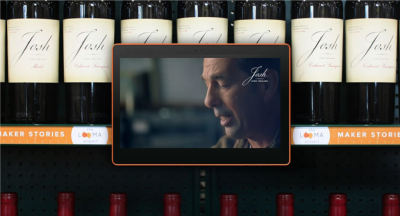Using technology for a human connection in consumer goods
I recently became aware of an interesting technique Harris Teeter and Lowe’s Foods are using in the wine sections in some of their stores. Bellomy wasn’t involved in researching the technique, but I felt it worthy of sharing.
Imagine you are walking down the wine aisle at your local grocer. As bottle after bottle, red after white, cross through your periphery, a sense of overwhelming choice begins to flood your brain. You know you need a cabernet sauvignon. So, you make your way to that section.
In turning to face the aisle, you are met with fifteen different options. You start to look at price, label, year, country – but something else catches your eye. It’s a tablet attached to the shelf.
 On the screen there is a video playing. You pause as a story unfolds in motion before your eyes: a story about a family who has bottled this brand of cabernet in the countryside of Napa for over 100 years. The clip ends and you find yourself reaching for that bottle. You have just narrowed your selection based on people and the connection you felt with their story which was presented during the shopping experience.
On the screen there is a video playing. You pause as a story unfolds in motion before your eyes: a story about a family who has bottled this brand of cabernet in the countryside of Napa for over 100 years. The clip ends and you find yourself reaching for that bottle. You have just narrowed your selection based on people and the connection you felt with their story which was presented during the shopping experience.
I discovered this was the dream of The Looma Project, a digital storytelling platform that connects shoppers with the brand story in-the-moment as they browse the aisle. According to StoreBrands.com (Nov. 7, 2019), The Looma Project is slated to add tablets to the beer and wine sections in more than 50 Lowes Foods stores in North Carolina before the end of 2020. That expansion comes in addition to being placed in most of the Harris Teeters in North and South Carolina last year.
But why are grocers beginning to emphasize the power of human connection? We think it is due to the changing nature of what shoppers value from the products they buy. The Looma Project is targeting the rising desire among consumers to feel more connected to the people, ingredients, and sources associated with the products they are buying.
This might be especially helpful in crowded sections where navigation is important. For instance, there is so much presented to the customer in areas like craft beer. What is the unique selling proposition of each of these brands? These tablets might actively slow down us down and cause us to consider our choices more thoughtfully and educate ourselves about premium products like wine and beer.
Looma appears to be aimed at bridging the gap between maker and consumer, communicating something very meaningful using only a small amount of real estate.

